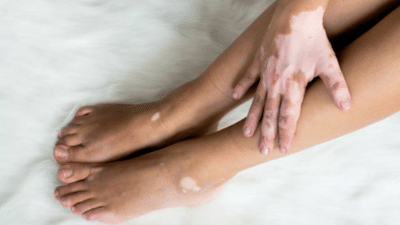
Vitiligo is a chronic autoimmune skin condition characterized by milky-white depigmented patches caused by the destruction of melanocytes—the cells responsible for skin pigmentation. It can begin at any age, though onset often occurs in the 20s–30s. While the precise trigger remains unclear, vitiligo arises when the immune system erroneously targets and destroys the melanocytes. Genetic predisposition, oxidative stress, and environmental factors—like skin injury or intense sun exposure—also play contributory roles.
Causes: An autoimmune root
Modern research emphasizes vitiligo as a true autoimmune disorder. Studies have identified immune-related genes linked to vitiligo susceptibility, as well as associations with other autoimmune conditions (thyroiditis, type 1 diabetes, rheumatoid arthritis, etc.). Often an external trigger—stress, sunburn, or skin trauma provokes the immune system’s attack on melanocytes
Common myths — debunked
Vitiligo is contagious.” False. It cannot be transmitted through touch, shared items, or bodily fluids.
“It’s caused by diet or poor hygiene.” False. No link exists with consuming specific foods (e.g., fish-and-milk combo or sour fruits) or with hygiene habits.
“Only dark-skinned people get it.” False. Vitiligo affects all ethnicities.
“It’s untreatable or can heal by itself.” Partly false. Although there's no permanent cure, multiple therapies (topical treatments, phototherapy, surgery) can restore pigmentation, though results vary.
Vitiligo vs. other pigment disorders
Vitiligo (a depigmentation disorder) differs significantly from hyperpigmentation conditions like melasma, which produces darker patches due to excess melanin. Melasma typically appears symmetrically on sun-exposed facial areas and responds to treatments like hydroquinone, tranexamic acid, antioxidants, and sun protection. Other conditions that mimic vitiligo include:
Tinea versicolor (a fungal infection)
Post-inflammatory hypopigmentation
Chemical leukoderma (pigment loss following chemical exposure)
Clear clinical evaluation—by a dermatologist—is essential to differentiate these conditions accurately.
When to seek help
Early dermatologic consultation is crucial if you notice:
• Chalky-white patches (often around the eyes, mouth, fingertips, joints)
• New or expanding skin lesions
• Premature graying of hair or white patches in the eyebrows, scalp, or oral mucosa.
Prompt diagnosis can help initiate treatment before vitiligo spreads, improving outcomes and reducing psychological burden.
Treatment options & emotional well-being
Medical & Surgical Therapies
• Topical corticosteroids and calcineurin inhibitors.
• Narrowband UVB phototherapy—often combined with topical agents—is a highly
effective option.
• Surgical procedures, such as melanocyte or skin grafting, may be considered for
stable, localized vitiligo
Newer advances include Janus kinase (JAK) inhibitors—e.g., topical ruxolitinib and laser therapies.
Emotional and social support
The visible nature of vitiligo often leads to stigma, anxiety, depression, and social withdrawal.
Highlighting this emotional toll reinforces why psychological support—via counseling and Peer groups are essential.
It is important to spread awareness about the non-contagious and harmless nature of vitiligo among the general public as well.
Vitiligo is a complex autoimmune condition rooted in immune dysfunction—not contagious, not related to hygiene or diet. Differentiating it from other pigmentation conditions and addressing myths helps reduce stigma. Early dermatologic care, coupled with psychological support and evolving therapies, can significantly improve quality of life. Societal awareness remains vital—embracing those with vitiligo as unique, not deficient.
Dr Rashmi Naldeega, Consultant Dermatologist, Practo
